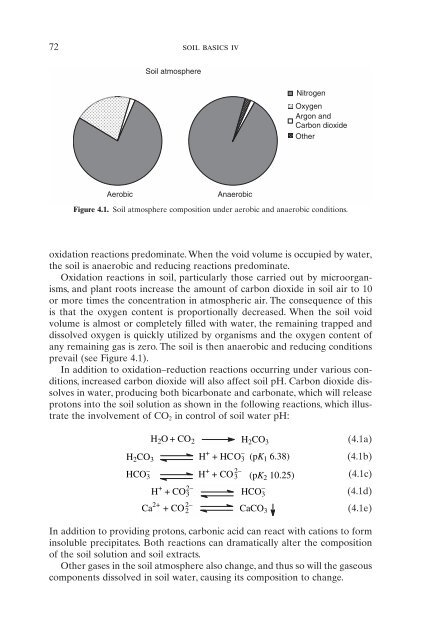Introduction to Soil Chemistry
Introduction to Soil Chemistry
Introduction to Soil Chemistry
Create successful ePaper yourself
Turn your PDF publications into a flip-book with our unique Google optimized e-Paper software.
72 soil basics iv<br />
<strong>Soil</strong> atmosphere<br />
Aerobic Anaerobic<br />
oxidation reactions predominate. When the void volume is occupied by water,<br />
the soil is anaerobic and reducing reactions predominate.<br />
Oxidation reactions in soil, particularly those carried out by microorganisms,<br />
and plant roots increase the amount of carbon dioxide in soil air <strong>to</strong> 10<br />
or more times the concentration in atmospheric air. The consequence of this<br />
is that the oxygen content is proportionally decreased. When the soil void<br />
volume is almost or completely filled with water, the remaining trapped and<br />
dissolved oxygen is quickly utilized by organisms and the oxygen content of<br />
any remaining gas is zero. The soil is then anaerobic and reducing conditions<br />
prevail (see Figure 4.1).<br />
In addition <strong>to</strong> oxidation–reduction reactions occurring under various conditions,<br />
increased carbon dioxide will also affect soil pH. Carbon dioxide dissolves<br />
in water, producing both bicarbonate and carbonate, which will release<br />
pro<strong>to</strong>ns in<strong>to</strong> the soil solution as shown in the following reactions, which illustrate<br />
the involvement of CO 2 in control of soil water pH:<br />
H + HCO3<br />
2–<br />
+ CO3 –<br />
HCO3 –<br />
H + + CO3 2–<br />
H2CO3 H<br />
(pK2 10.25)<br />
+ + HCO3 – H2O + CO2 H2CO3 (pK1 6.38)<br />
Ca 2+ + CO 2 2–<br />
CaCO3<br />
Nitrogen<br />
Oxygen<br />
Argon and<br />
Carbon dioxide<br />
Other<br />
Figure 4.1. <strong>Soil</strong> atmosphere composition under aerobic and anaerobic conditions.<br />
(4.1a)<br />
(4.1b)<br />
(4.1c)<br />
(4.1d)<br />
(4.1e)<br />
In addition <strong>to</strong> providing pro<strong>to</strong>ns, carbonic acid can react with cations <strong>to</strong> form<br />
insoluble precipitates. Both reactions can dramatically alter the composition<br />
of the soil solution and soil extracts.<br />
Other gases in the soil atmosphere also change, and thus so will the gaseous<br />
components dissolved in soil water, causing its composition <strong>to</strong> change.
















